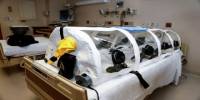A recent study emphasizes the potential of synthetic DNA constructs that, when combined with antibodies, direct the immune system to target malignant cells in particular.
A particularly promising tool in the war against cancer is immunotherapy. In essence, the goal is to stimulate the immune system of the body to recognize and eliminate cancerous cells. To prevent harming healthy cells, the destruction must be as precise and effective as possible.
A team of researchers from LMU, the Technical University of Munich (TUM) and Helmholtz Munich have now published a new study in Nature Nanotechnology in which they present a promising method for developing user-defined agents that can do precisely that.
“The centerpiece is a tiny chassis of folded DNA strands that can be specifically fitted with any antibodies,” explains Professor Sebastian Kobold, one of the main authors. At Munich University Hospital, his team has investigated the impact of the new substrates both in vitro and in vivo.
Using DNA origami to recruit T-cells
DNA origami, a nanotechnology in which self-folding DNA strands arrange themselves into a structure simulated in advance on a computer, is used to create this novel class of agents, dubbed “programmable T-cell engagers” (PTEs). Their design allows different antibodies to be attached in four positions.
We believe that our findings will permit the clinical testing of DNA nanotechnologies and demonstrate the potential of biomolecular, DNA-origami-based engineering strategies for medical applications.
Professor Sebastian Kobold
On one side, antibodies that attach precisely to certain tumor cells are added, while on the other, antibodies that the immune system’s T-cells can detect are placed. T-cells then destroy the marked cells.
“This approach permits us to produce all kinds of different PTEs and adapt them for optimized effects,” says Dr. Adrian Gottschlich, one of the study’s lead authors. “Infinite combinations are in theory possible, making PTE a highly promising platform for treating cancer.”
For the study, the researchers created 105 distinct antibody combinations and tested them in vitro to determine how precisely they bound to the target cells and how successfully they attracted T cells. Without the formerly very time-consuming tuning of the antibodies, the combinations may be created in a modular manner.
The team was able to prove that more than 90% of the cancer cells had been destroyed after 24 hours. To find out whether this also worked in living organisms, Professor Kobold and his colleagues examined whether PTEs also recognize and induce the destruction of cancer cells in tumor-bearing organisms.
“We were able to prove that our PTEs made from DNA origami structures also work in vivo,” Gottschlich says.
Versatile and user-defined
According to Gottschlich, tumor cells can be targeted considerably more accurately since many antibodies can be mounted simultaneously. Additionally, it is simpler to manage immune system activity. By more effectively differentiating between sick and healthy cells, this raises the likelihood of successfully treating cancer while reducing side effects.
Given the modularity, adaptability, and high degree of addressability of DNA origami technologies, the researchers anticipate that a wide range of intricate and even logic-controlled immunotherapy platforms can be created.
TUM scientists Dr. Klaus Wagenbauer, Dr. Benjamin Kick, Dr. Jonas Funke and Professor Hendrik Dietz all number among the founders of Plectonic Biotech GmbH that wants to further develop and market the technology underpinning PTEs.
Sebastian Kobold says, “We believe that our findings will permit the clinical testing of DNA nanotechnologies and demonstrate the potential of biomolecular, DNA-origami-based engineering strategies for medical applications.”
















